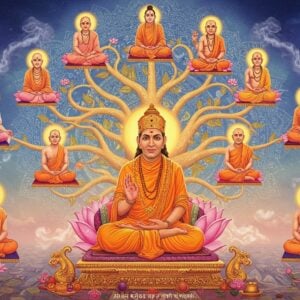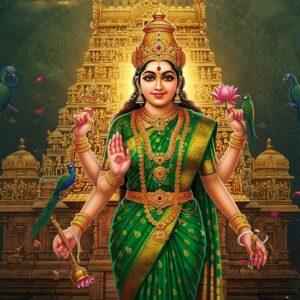
In Hindu mythology, Devi, the Sanskrit term for “goddess,” embodies the divine feminine energy, deeply revered in Shaktism and Shaivism traditions. These narratives offer profound insights into morality, spirituality, and the power of the divine feminine. Let’s delve into some captivating Devi myths and their cultural impact.
The Steadfast Sisters: Ma Vindhyavasini, Ma Kali, and Ma Ashtabhuja
During King Kansa’s reign, three goddesses—Ma Vindhyavasini, Ma Kali, and Ma Ashtabhuja—endeavored to guide the cruel king toward a righteous path. Their wisdom, however, was disregarded by Kansa, who banished them from his court. Undeterred, the sisters orchestrated a plan to end Kansa’s tyrannical rule. They ensured Devaki and Vasudeva’s eighth child would be Krishna, an avatar of Vishnu destined to overthrow Kansa. This tale underscores the victory of good over evil and the goddesses’ pivotal role in upholding dharma. The sisters represent the combined strength of feminine wisdom and determination against tyranny and injustice.
Durga’s Triumph Over Mahishasura
Durga’s legend stands as a testament to her valor and divine power. A fierce manifestation of Mahalakshmi, she appears as a warrior goddess adorned with multiple arms, each wielding a divine weapon. Mounted upon a tiger or lion, she confronts the formidable buffalo demon Mahishasura, a threat to the cosmic balance. Durga’s victory reinstates divine order, a triumph celebrated during Durga Puja. This festival honors her courage and strength, reminding devotees of her unwavering protection against malevolent forces. The imagery of Durga’s multi-armed form symbolizes her all-encompassing power and ability to combat various forms of evil.
Explore more about powerful goddesses like Chhinnamasta Devi on poojn.in.
Parvati’s Devotion and Rebirth
Parvati’s story is deeply intertwined with her previous life as Sati, daughter of King Daksha. Sati’s self-immolation due to her father’s disrespect towards her husband, Shiva, is a poignant tale of sacrifice and love. Reborn as Parvati, she undergoes intense penance to reunite with Shiva, demonstrating the transformative strength of devotion. This narrative illuminates the themes of love, sacrifice, and the unwavering pursuit of divine union. Parvati’s journey emphasizes the power of devotion and the cyclical nature of life, death, and rebirth within Hindu cosmology.
Discover ancient Shiva temples in Maharashtra and learn more about the divine couple on poojn.in.
Vaishno Devi: A Mother’s Wish Fulfilled
The legend of Vaishno Devi illustrates the multifaceted nature of feminine strength. Born to a mother who prayed for a daughter stronger than any son, Vaishno Devi embodies guidance, protection, and comfort. She is a source of solace and strength, demonstrating the diverse aspects of feminine power. This tale inspires recognition of the inherent strength and divine potential within women, fostering a sense of empowerment and self-belief. Vaishno Devi’s story celebrates the diverse strengths women possess, highlighting their ability to nurture, protect, and guide.
Nanda Devi: Embracing the Mountain
Princess Nanda’s transformation into Nanda Devi, the Mother Goddess, highlights resilience and the profound connection between the feminine and nature. To escape an unwanted marriage, she becomes one with the mountain, symbolizing a harmonious union with the natural world. Nanda Devi represents the protective embrace of nature and the enduring spirit of a woman choosing her own destiny. Her story demonstrates a deep connection between the feminine and the natural world, celebrating the protective and nurturing aspects of both.
Devi’s Conquest Over Chanda and Munda
Devi’s battle against the demons Chanda and Munda showcases her protective nature. Their threat to cosmic harmony is met with Devi’s decisive victory, reaffirming the dominance of divine order. This story reminds believers of Devi’s unwavering support in times of adversity. She acts as a guardian against chaos, preserving balance and protecting the righteous. This victory underscores the importance of divine intervention in maintaining cosmic order and protecting the universe from malevolent forces.
Kali: The Power of Righteous Fury
Kali, often depicted in her fierce form, imparts a crucial lesson about the constructive use of anger. She teaches Paro that tragedies do not define one’s identity and that righteous anger, when directed towards those causing harm, can be a powerful force for justice. Kali embodies the transformative power of anger when channeled towards protection and the pursuit of righteousness. She empowers individuals to confront injustice and defend themselves against harm.
Sita: Embodiment of Virtue
Sita, revered as one of the Panchakanya (five virgins), embodies virtue and moral strength. Her story, interwoven with the epic Ramayana, imparts valuable spiritual and ethical teachings. Sita’s unwavering devotion to her husband Rama and her enduring resilience throughout their trials serve as a moral compass, illuminating the virtues of patience, loyalty, and integrity. Her story offers profound lessons in dharma and the importance of upholding one’s values in the face of adversity.
Explore Sanskrit mantras and deepen your spiritual understanding on poojn.in.
These diverse narratives celebrate the multifaceted nature of the divine feminine, each offering unique insights and guidance for life’s journey. They showcase Devi’s enduring presence, providing protection, wisdom, and unwavering support to those who seek her blessings.
Find beautiful murtis of deities like Lord Shiva on poojn.in to enhance your personal altar.Poojn.in also offers essential puja items like camphor for your daily rituals.


